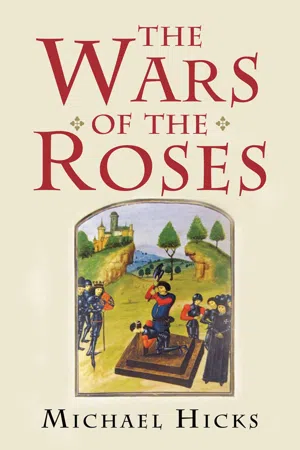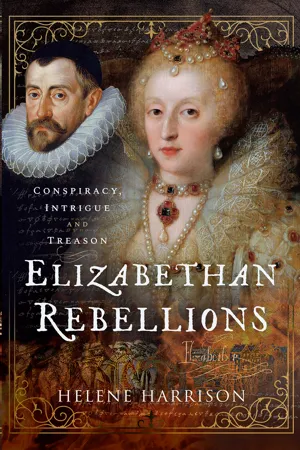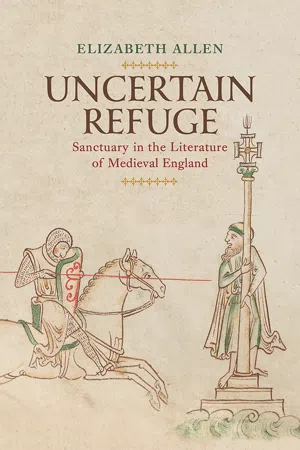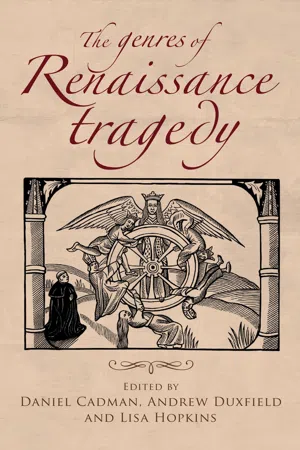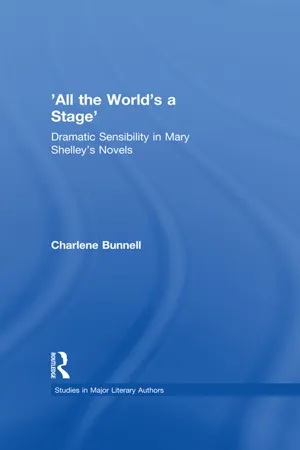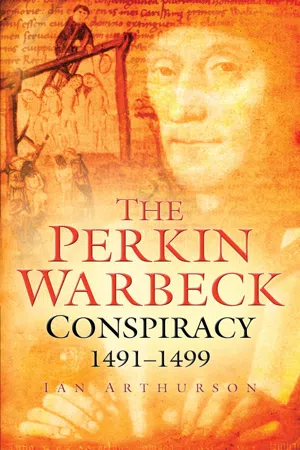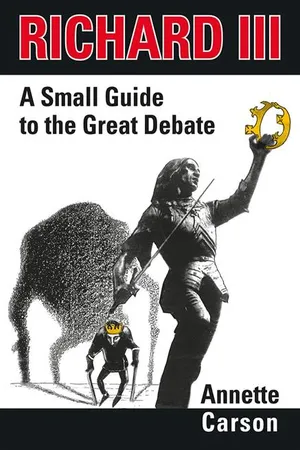History
Perkin Warbeck Rebellion
The Perkin Warbeck Rebellion was a series of attempts by Perkin Warbeck, who claimed to be Richard, Duke of York, to overthrow King Henry VII of England. Warbeck's claim to the throne was based on his assertion that he was one of the Princes in the Tower, who were believed to have been murdered. The rebellion ultimately failed, and Warbeck was captured and executed.
Written by Perlego with AI-assistance
Related key terms
10 Key excerpts on "Perkin Warbeck Rebellion"
- eBook - ePub
- Michael Hicks(Author)
- 2010(Publication Date)
- Yale University Press(Publisher)
Henry VII continued to fear Ricardian insurgency in the North and treated the Yorkshire Rebellion of 1489 as such, wrongly as we now know, but the defeat of Ricardianism did not terminate the challenges to his throne. The Battle of Stoke was not the end. There remained alternative candidates for the Crown. There were to be further conspiracies, rebellions and even invasions. Margaret of Burgundy sheltered more dissidents, funded their plots and invasions, and so indeed did the Scots. There were to be two major popular revolts, in Yorkshire in 1489 and in the West Country in 1497. These destabilizing elements did not interact and were not to remove Henry VII from the throne. Yet the threats were real for another fifteen years at least. What links the most serious from 1491 to 1497 was Perkin Warbeck.Like Simnel, Warbeck was a youth of modest stock. Most probably he was a son of Jehan and Nicaise de Werbecque, a prosperous mercantile family of Tournai in northern France, who embarked early on an appenticeship in trade in Burgundy and courtly service in Portugal, whence he was plucked in Ireland as a suitable impostor for the younger of Edward IV's sons and Prince in the Tower, Richard, Duke of York. In time he styled himself King Richard. Warbeck had the noble demeanour, manner and manners required of a prince and courtier. He was literate and must also have been a brilliant linguist, fluent in French, Flemish, English, perhaps also Portuguese and Latin. His imposture convinced many with no desire to be convinced as well as those, like his supposed aunt Margaret, who were looking for a credible Yorkist claimant. He was admitted to the courts of the Empire, Burgundy and Scotland, and treated with much more honour than most pretenders. Warbeck even married in Lady Katherine Gordon a noble lady connected to the Scottish Crown. Yet he was an impostor. Nothing suggests either political competence or military capacity, whether in generalship, prowess, or courage. Presumably he did not have the conventional aristocratic education at arms and was indeed ‘a prince for chambers and gardens’.34Yet Warbeck did have about him men who knew Edward IV's court, current English affairs, and much else of relevance. Indeed, at times his court in exile in Burgundy and Scotland was several hundred strong and comparable perhaps to that of Henry Tudor in 1484–5. Like Margaret of Anjou before him, Warbeck was an important pawn on the international scene, who was harboured by all the principal powers in turn, received military aid for invasions of Kent from Burgundy in 1495 and of northern England from Scotland in 1496, and sought to combine this activity with internal conspiracies. Much more is now known both of the international dimension35 and of those prosecuted in England. It remains uncertain whether the defendants were all the plotters there were or just the most important. ‘The names of the plotters are thus in no sense random, but closely associated with the royal court and its children.’ They failed because Henry's ‘network of spies was superb’ and because Henry broke Warbeck's English support.36 - eBook - ePub
Elizabethan Rebellions
Conspiracy, Intrigue and Treason
- Helene Harrison(Author)
- 2023(Publication Date)
- Pen and Sword History(Publisher)
The Perkin Warbeck Rebellion, although still a rebellion headed by a pretender to the throne, posed more of a threat to the English throne than the Lambert Simnel Rebellion. The Warbeck Rebellion lasted over a longer period of time than the Simnel Rebellion, and it came closer to success in many ways. Unlike the Earl of Warwick in the Simnel Rebellion, Richard, Duke of York could not be paraded through the streets of London to prove the pretender was a fake. No one knew with confidence whether the Princes in the Tower were dead, and no bodies had been recovered that we know of for certain, or that have made it into the records. Skeletons recovered in the Tower of London in 1674 which had been buried under a staircase in the White Tower were placed in an urn on the orders of Charles II and interred in Westminster Abbey. These were assumed to be the remains of the Princes in the Tower but there is no evidence, and the remains have not been examined.Perkin Warbeck was the son of a Tournai man, John Osbeck, and his wife, Katherine de Faro, and was said to have a striking resemblance to Edward IV, the father of the Princes in the Tower. His own confession given at the time of his capture by Henry VII’s troops, suggests he was born into an educated family, comfortably off if not wealthy, in the French town of Tournai.7 His father was described as the comptroller to the city of Tournai. His name is sometimes spelt as Pierrechon de Werbecque, but the English seem to have changed it to Perkin Warbeck. Warbeck’s confession was obtained under duress, so the veracity of what he said cannot be guaranteed.Warbeck arrived in Cork, Ireland, in the employ of a Breton merchant called Pregent Meno. He was parading around advertising some of his employer’s wares when the citizens declared him to be Edward, Earl of Warwick. He had to swear an oath to refute this. It was then thought that he was a bastard son of Richard III, which would not have made him a legitimate claimant to the English throne anyway. Warbeck later claimed that it was against his will that some Yorkist adherents, including the former mayor of Cork, John Atwater, declared him to be Richard, Duke of York, younger of the Princes in the Tower, and made him learn English, royal history, and manners. - eBook - ePub
Uncertain Refuge
Sanctuary in the Literature of Medieval England
- Elizabeth Allen(Author)
- 2021(Publication Date)
- University of Pennsylvania Press(Publisher)
But the “new-coin’d greatness” of Perkin Warbeck represents competition; it is temporally disjunctive, an innovative currency as much as a ghostly affront to Henry’s performance of kingship. It threatens to reinjure the scarred body politic of England, whose “rent face” is barely healed. Henry sees himself as a regulator and physician: his work, his monarchical art, consists of negotiations and profferings of peace in the realm, including taxation, payment to his loyal soldiers, and eventually, lifetime support to Perkin’s wife, Katherine Gordon. 52 Perkin Warbeck himself does not appear until act 2. While this formal maneuver allows Henry to define his competitor, it also registers his rival’s powerful influence upon others and, when he finally appears, his sheer attractiveness. Even before the pretender appears onstage, his proximity—and the temporal proximity of the chaotic medieval past to the peaceable Tudor present—suggests the precariousness of Henry’s kingship and his advance into modernity. Henry himself is “frighted,” at risk, and insecure, laboriously protecting his inheritance. Kingship here is no safe, stable, uncontested entitlement but instead an ongoing effort to extract the country from a violent but compelling past. Perkin Warbeck, whose eloquence and bearing represent an entirely different sort of kingship, continually calls Henry’s modern pragmatism into question. The depiction of Perkin invokes a past shaped by sanctuary—that practice that calls upon the exceptional generosity of the monarch whose power is sufficiently established that he can tolerate the ceding of control that pity necessarily involves. Ultimately Perkin lacks the power to enact mercy or protect anyone; his “kingship” ratifies a practice of sanctuary as tentative and affect-based as that of Thomas More - eBook - ePub
- Daniel Cadman, Andrew Duxfield, Lisa Hopkins(Authors)
- 2019(Publication Date)
- Manchester University Press(Publisher)
Perkin Warbeck provides a crucial lens through which we can view, and review, the genre of historical tragedy, particularly in terms of the play's relationship with Shakespeare and his legacy.Written c. 1629–34, at a time when the history play was no longer at the height of its popularity, Perkin Warbeck is self-conscious about its unfashionable status: ‘Studies have, of this nature, been of late / So out of fashion, so unfollowed …’ (Prologue, 1–2).2 By acknowledging its own distance from Shakespeare's history plays of the 1590s, the play appears to look at the genre as itself a kind of historical artefact – antiquated and all but obsolete. Yet, although Perkin Warbeck is written some three decades after the majority of Shakespeare's histories were first written and performed, its composition is historically more proximate to the publication of Shakespeare's First Folio in 1623. The Folio is roughly contemporaneous with one of Ford's sources for the play, Bacon's The History of the Reign of King Henry VII (1622); the other main source, Gainsford's The True and Wonderful History of Perkin Warbeck, was published not long before, in 1618. The Folio constitutes an important retrospective of Shakespeare's achievements as a writer of history plays; this is reflected in the title of the volume, Mr. William Shakespeare’s Comedies, Histories, & Tragedies, and in its catalogue of plays in which the histories are grouped as a discrete category. The Folio can be regarded, in some sense, as a source text for Perkin Warbeck since Ford's play extends and revises the retrospective of Shakespeare's history plays which the Folio began. Ford's engagement with Shakespeare is particularly evident when we consider that in chronological terms, the narrative of Perkin Warbeck can be inserted between Shakespeare's Richard III (written c. 1591) and Henry VIII (written 1612–13) and it explicitly alludes to events in each of these plays. In this sense, Perkin Warbeck - eBook - ePub
'All the World's a Stage'
Dramatic Sensibility in Mary Shelley's Novels
- Charlene Bunnell(Author)
- 2013(Publication Date)
- Routledge(Publisher)
HAPTER SEVENPerkin Warbeck: Problematic Roles and IdentitiesHere has appeared, though in a several fashion, The threats of majesty, the strength of passion, Hopes of an empire, change of fortunes; all What can to theatres of greatness fall, Proving their weak foundations.— John Ford, Epilogue to Perkin WarbeckJ ohn Ford, perhaps better known for his tragedies ‘Tis Pity She’s a Whore and The Broken Heart, also wrote the historic drama Perkin Warbeck (1634), based on a pretender to Henry VII’s throne who claimed to be Richard IV. Warbeck professed to be the Duke of York, Edward VI’s second son, who, with his elder brother, was imprisoned by his uncle, Richard III. The fate of the princes in the tower has never been completely resolved, although many historians presume they were murdered and discredit Perkin’s assertion. However, Mary Shelley believed otherwise. In the preface to her novel, The Fortunes of Perkin Warbeck (1830), she wrote: “It is not singular that I should entertain a belief that Perkin was, in reality, the lost Duke of York. … no person who has at all studied the subject but arrives at the same conclusion. Records exist … which put the question almost beyond a doubt.”1 (Perkin Warbeck, v–vi).While sympathetic toward the character of Perkin, John Ford does not examine him in depth in the play; in fact Perkin is merely one of many figures and is even secondary to Henry VII, James IV of Scotland, and Huntley (father of Katherine Gordon). In contrast to Ford, Shelley saw Richard as “a fitting object of interest — a hero to ennoble the pages of a humble tale” (Perkin Warbeck, preface, viii). Mary Shelley diligently and thoroughly researched a variety of sources to present a complete picture of Richard.2 Reading through the various documents on the subject, she realized how many of these accounts slight Richard’s history: “I became aware of the romance which his story contains, while, at the same time, I felt that it would be impossible for any narration, that should be confined to the incorporation of facts related by our old Chroniclers, to do it justice” (Perkin Warbeck, preface, v). The facts do not “do it justice” because they frequently omit the important facets of private life. Although careful to preserve accuracy, she recognized that the historical novelist, as James Kerr notes, “not only combines romance with ‘reality,’ but, viewing history as simply another way of seeing things that is at odds with the perspective of romance, writes history anew.”3 The historical novel is not merely a factual recording of public events, as noted in the prior chapter. It is also a revision of history as it explores the potential drama of daily existence: “In order to glean the dramatic from history, we must first realize that drama is fashioned out of the sadness and laughter in the happenings of everyday experience. All drama is hewn out of the basic materials of life: human personalities, their loves, their longings, their clashes. And so, we must train our powers of observation and our insights and apply them to the life around us.”4 So, like Valperga, Mary Shelley’s fifth major work is an historical romance that explores the problematic roles and private lives of public figures, and also like one of her sources, Francis Bacon’s History of Henry VII, it presents the life of an historical figure who had an existence off as well as on the public stage.5 - eBook - ePub
- Ian Arthurson(Author)
- 2009(Publication Date)
- The History Press(Publisher)
33 How could it be? Warbeck as Richard Plantagenet was neither genuinely a prince of York nor purely the product of his own inventing. He could not be treated, as Margaret of Anjou had been by Edward IV as deserving of exile. Nor could he be treated as one so deluded that he was a diplomatic irrelevance. Those on whose behalf he had functioned were still at liberty, and the nominal master of some of these men, the Earl of Warwick, was still alive. It might be true that Richard Plantagenet was now dead. Having been reborn in Cork he had been buried at Taunton. Perkin Warbeck, however, had to disinter himself there, after almost ten years of the masquerade. This as we saw in his letter to his mother would be difficult and confusing. He could neither be rescued by Maximilian, nor could he resume the life of a citizen of Tournai with his family. The only possibility in the present lay at the English court, as a subject of Henry VII.Elizabeth of York, Queen of EnglandOnce the rebellions of 1497 were over Henry treated Warbeck well. Both the London Chronicles comment that the king extended his grace to Warbeck and that he was at liberty in the English court, so much, said the Great Chronicle , that it would take a great deal of space to describe it.34 Vergil and Hall maintain that he was kept under constant surveillance to prevent his use as a figurehead in fresh trouble. Both these versions of Warbeck’s fate compliment each other. Generally he was supervised by Robert Jones and William Smyth, two of Henry’s household officials. Smyth was a wardrobe official of who worked his way up from Page of the Wardrobe to Groom of the Robes, while creaming off numerous grants of lands forfeited by rebels. Jones along with James Braybrook, a yeoman of the chamber, received payments on Warbeck’s behalf. Nevertheless Warbeck also had two yeomen servants, Londoners – John Kebyll and John Sherwyn, to guard him at night.35 However, while it is true that Warbeck was well guarded it is also the case that Hall and Vergil use every opportunity to increase the dramatic tension of their dynastic histories by contrasting the virtue of the Tudor dynasty with the threat from its opponents.36 It is possible that in the spring of 1498 Warbeck was about to resume in England the career of a minor courtier he had abandoned when he left Portugal. Both he and his wife were placed at court, though the king would not allow them to sleep together. In late November 1497 Andrea Trevisano, the Venetian ambassador, saw Warbeck in a chamber at the palace of Westminster. ‘He is a well favoured young man 23 years old, and his wife a very handsome woman.’37 In December 1497 Henry personally gave Katherine Gordon a gift of £2, and in mid-March of 1498 James Braybrook laid out £2 for Perkin and another £2 for one of his wife’s servants. Warbeck even had his own tailor, one Jasper.38 - eBook - ePub
Warwickshire
The Land of Shakespeare
- Clive Holland(Author)
- 2014(Publication Date)
- Perlego(Publisher)
A few years later the House of Warwick became allied to that of York by the marriage of Richard III. with Anne, daughter of the Earl of Warwick, and widow of the unhappy Edward V., who had been murdered by Richard, his uncle.The final struggle between the rival Roses took place not in Warwickshire, but in its sister county Leicestershire at Market Bosworth, in the sanguinary battle of August 22, 1485, which by the defeat and death of Richard III. brought the Plantagenet line of English sovereigns to an end.Upon the accession of Henry of Richmond after the battle of Bosworth, the Earl of Warwick, son of the Duke of Clarence, was imprisoned in the Tower. And on the advent of Perkin Warbeck, who represented himself to be Richard, Duke of York, son of Edward IV., the fact of Warwick’s imprisonment was used by King Henry VII.’s enemies to his injury and disparagement.The fate of Warbeck was destined ultimately to involve that of the unfortunate Earl of Warwick. Bacon puts the position in a brief phrase, which cannot be easily surpassed for vivid imagery. He says, “it was ordained that the winding ivy of a Plantagenet should kill the true tree itself.”By the execution of the Earl upon Tower Hill in 1499 the male line of the Plantagenets, which had flourished in great royalty, power, and renown from the time of Henry II., came to an end; and there was no other Earl of Warwick for a period of nearly half a century.Passage contains an image
CHAPTER II
WARWICKSHIRE AND ITS HISTORY FROM THE FIFTEENTH CENTURY TO MODERN TIMESFor many years after the decisive battle of Bosworth the history of Warwickshire was marked rather by peaceful and steady progress than by events of intense interest. No great occurrence of a military or catastrophic character disturbed its sunny hills and fertile vales. And even during the reign of Edward VI., which witnessed the historical struggle between the Duke of Somerset and Earl of Warwick for power, Warwickshire enjoyed a period of rest and tranquillity, unaffected by the schemes and plotting of John Dudley, who had been created Earl of Warwick by the King. - eBook - ePub
Shakespeare's History
Mirrors of Elizabethan Policy.
- Lily B Campbell(Author)
- 2013(Publication Date)
- Routledge(Publisher)
These same northern lords had been as insistent in their demands that Elizabeth rescue Mary from her incarceration by the Scots before her escape and flight to England as they were now to be insistent that she be released from her imprisonment in England. It is thus apparent that the combined wrath of the Percies over Henry's failure to ransom Mortimer, the pretender, and over his demand that they hand over the Scotch prisoners may well be patterned by the demands of the northern lords that Mary, the pretender, be released, and that Mary, the Scotch prisoner, be left in the keeping of the Elizabethan Percy.As to the main action of the play, I have already pointed out that Shakespeare compressed the events of years into a short space of time, and three rebellions into two phases of a single rebellious surge against the king. The rebellion which Shakespeare showed spent itself at Shrewsbury, and in spite of the renewed effort under the Archbishop of York, flickered out in an atmosphere of weakness and discouragement and disaffection on the part of the rebels when they met determined resistance from the king's forces. The picture is not a true picture of the rebellions against Henry IV, but it is a true picture of the rebellion of 1569 against Elizabeth, for after the battle for Bernard's Castle, which was seized by the rebels, the queen's forces were successfully organized, and the rebellion died a death of attrition. The compiler of the Annals of the House of Percy says of the last phases of the rebellion, when the rebels were forced to go ahead without the promised support of the other lords and foreign powers:The conduct of the ensuing campaign, if a series of desultory marches and purposeless manoeuvres, can be dignified by the term, does not admit explanation upon any principles of the art of war.25The leaders of the rebellions against Henry IV and the leaders in the Rebellion of the North against Elizabeth are, then, similar enough to invite comparison. The rebellion which Shakespeare drew was motivated and carried out with greater resemblance to the rebellion of 1569 than to the three rebellions under Henry IV, which it telescopes. But in addition to these likenesses, it must be remembered that as Worcester justified the rebellion against Henry IV as a necessity because of the oppressions and wrongs which the king was heaping upon the ancient nobility which had been the ladder by which he ascended the throne, so the Earls of Northumberland and Westmoreland proclaimed that they intended to do no harm to the queen or her good subjects but only to amend and redress the wrongs included under the following whereas - eBook - ePub
- Charles Dickens(Author)
- 1996(Publication Date)
- Perlego(Publisher)
At last Perkin Warbeck ran away, and took refuge in another sanctuary near Richmond in Surrey. From this he was again persuaded to deliver himself up; and, being conveyed to London, he stood in the stocks for a whole day, outside Westminster Hall, and there read a paper purporting to be his full confession, and relating his history as the King’s agents had originally described it. He was then shut up in the Tower again, in the company of the Earl of Warwick, who had now been there for fourteen years: ever since his removal out of Yorkshire, except when the King had had him at Court, and had shown him to the people, to prove the imposture of the Baker’s boy. It is but too probable, when we consider the crafty character of Henry the Seventh, that these two were brought together for a cruel purpose. A plot was soon discovered between them and the keepers, to murder the Governor, get possession of the keys, and proclaim Perkin Warbeck as King Richard the Fourth. That there was some such plot, is likely; that they were tempted into it, is at least as likely; that the unfortunate Earl of Warwick—last male of the Plantagenet line—was too unused to the world, and too ignorant and simple to know much about it, whatever it was, is perfectly certain; and that it was the King’s interest to get rid of him, is no less so. He was beheaded on Tower Hill, and Perkin Warbeck was hanged at Tyburn.Such was the end of the pretended Duke of York, whose shadowy history was made more shadowy—and ever will be—by the mystery and craft of the King. If he had turned his great natural advantages to a more honest account, he might have lived a happy and respected life, even in those days. But he died upon a gallows at Tyburn, leaving the Scottish lady, who had loved him so well, kindly protected at the Queen’s Court. After some time she forgot her old loves and troubles, as many people do with Time’s merciful assistance, and married a Welsh gentleman. Her second husband, Sir Matthew Cradoc , more honest and more happy than her first, lies beside her in a tomb in the old church of Swansea.The ill-blood between France and England in this reign, arose out of the continued plotting of the Duchess of Burgundy, and disputes respecting the affairs of Brittany. The King feigned to be very patriotic, indignant, and warlike; but he always contrived so as never to make war in reality, and always to make money. His taxation of the people, on pretence of war with France, involved, at one time, a very dangerous insurrection, headed by Sir John Egremont, and a common man called John à Chambre. But it was subdued by the royal forces, under the command of the Earl of Surrey. The knighted John escaped to the Duchess of Burgundy, who was ever ready to receive any one who gave the King trouble; and the plain John was hanged at York, in the midst of a number of his men, but on a much higher gibbet, as being a greater traitor. Hung high or hung low, however, hanging is much the same to the person hung. - eBook - ePub
- (Author)
- 2013(Publication Date)
- Imprimis Imprimatur(Publisher)
Another substantial faction supported Edward V in spite of everything and objected to Richard supplanting him. At the head of this faction was the Woodville family and their adherents, who foresaw an end to their hopes of being the ruling power. Their leaders were soon whipping up resistance.It goes without saying that once the tussle for power had been initiated, there had to be a winning party and a losing party. People in mediaeval times knew very well the potential price for challenging the king – they knew the risks and were prepared to take the gamble, so it was not a case of blundering into a situation with their eyes closed.They could have made their peace and accepted the position which clearly had the backing of the members of Parliament gathered in London, a body which at this time was gradually growing in status and influence. But instead they fomented armed rebellion with the aim of eliminating Richard and restoring Edward V.In the process, they deliberately revived the old faction-fighting which had blighted England during Henry VI’s reign, re-igniting the feud between Lancaster and the ruling Yorkists. They did this by spreading their tentacles to the Continent, allying themselves with a prominent Lancastrian, Henry Tudor, who was living in self-imposed exile in Brittany having refused to reconcile with the house of York. Though they supposed they had enlisted him to the cause of Edward V, the truth of the matter was that Tudor and his ambitious family and supporters were all the while looking to further their own interests.One may sympathize with the losing side, and one can certainly sympathize with the little boy who was deprived of the crown. Nor can it be claimed that Richard’s accession to the throne was bloodless, although the number of deaths involved may be counted on the fingers of one hand. But the actions of his opponents, and the bloodshed and civil strife to which they subjected the people of England in furthering their objectives, are difficult to justify.
Index pages curate the most relevant extracts from our library of academic textbooks. They’ve been created using an in-house natural language model (NLM), each adding context and meaning to key research topics.
